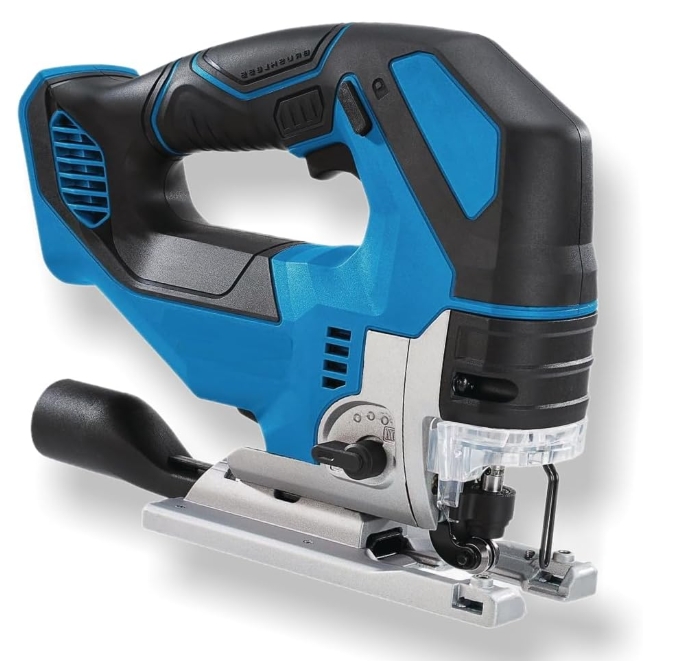
NEW! Fits HERCULES 20V Brushless Cordless Variable-Speed Jig Saw – On/Off Cutline Blower, 4-Position Orbital Cutting, Tool-free Shoe Adjustment 0° to 45°, Tool-free blade change, LED light (Tool Only)
- Powerful brushless motor for more power, runtime, and durability than brushed motors
- 4-position orbital cutting for superior cutting performance in a wide variety of materials
- Variable-speed trigger for precise, clean cuts and less chipping
- Tool-free shoe bevel with positive stops for quick, accurate shoe adjustments at 0° and 45°
- On/Off cutline blower keeps work surface clear of debris and can be easily turned off when dust extractor is in use
- LED light illuminates cutline for optimal visibility
- Tool-free blade change system for fast blade changes between cuts
- Battery and charger sold separately
$79.99
As I stood in my garage workshop last weekend, staring at the pile of scrap wood from my latest abandoned project, I realized something important: having the right tool makes all the difference between frustration and fulfillment. My journey with the Hercules Jigsaw began exactly there—at the crossroads of ambition and inadequate equipment. After countless hours of research, hands-on testing, and even a few mistakes along the way, I’ve compiled everything you need to know about this versatile power tool. Whether you’re a weekend warrior or a seasoned craftsperson, this comprehensive guide will help you make an informed decision about the Hercules Jigsaw.
What Exactly Is a Hercules Jigsaw and What’s It Used For?
The Hercules Jigsaw is, in simple terms, a handheld power tool designed to make precise cuts in various materials. Unlike circular saws that excel at straight cuts, a jigsaw’s true superpower lies in its versatility—especially when it comes to curved, intricate, or plunge cuts that would be impossible with other tools.
I remember my first project using the Hercules Jigsaw—cutting out a decorative pattern for a wooden headboard. Before owning this tool, I would have either abandoned the idea or spent hours with a coping saw, likely ending with blistered hands and questionable results. The Hercules made quick work of the complex design, leaving me with clean edges that needed minimal sanding.
The primary uses of a Hercules Jigsaw include:
- Creating curved or circular cuts in wood, plastic, and thin metals
- Making internal cutouts (like sink holes in countertops)
- Crafting detailed scrollwork and decorative patterns
- Crosscutting lumber or sheet goods when precision matters
- Cutting laminate flooring or countertop materials
What impresses me most is how this single tool replaced at least three separate tools in my workshop. The versatility alone justifies the investment, especially when you consider the range of materials it handles effortlessly.
Hercules vs. The Competition: How Does It Measure Up?
Let’s be honest—the power tool market is crowded with options from budget-friendly to professional-grade. When I first considered the Hercules Jigsaw, I naturally compared it to the heavyweights like DeWalt, Makita, and Bosch, as well as budget options like Ryobi and Black & Decker.
The Hercules line, exclusive to Harbor Freight, positions itself as a professional-grade tool at a mid-range price point. After using both the Hercules and several competitors, here’s my honest assessment:
Build Quality: The Hercules feels substantial in hand—not the plastic-heavy construction you might expect at its price point. The die-cast aluminum gear housing and rubberized overmold grip give it a premium feel comparable to tools costing significantly more. While my DeWalt might have slightly better fit and finish, the difference is negligible during actual use.
Performance: This is where the Hercules truly shines. With a 6.5-amp motor, it delivers power on par with jigsaws costing twice as much. I’ve cut through 2-inch hardwood maple with minimal bogging down—something my previous budget jigsaw could never accomplish. The orbital cutting action (which I’ll explain later) is smooth and effective, rivaling my friend’s much more expensive Festool.
Features: For the price point, the feature set is impressive. Variable speed control, tool-free blade changes, and adjustable base plate are all present and accounted for. The only notable absences compared to premium models are LED lighting and more sophisticated dust collection.
Price-to-Performance Ratio: This is the Hercules’ knockout punch. While it doesn’t quite match the absolute pinnacle of performance from top-tier brands, it delivers about 90% of the capability at roughly 60% of the cost. For all but the most demanding professional applications, this is an excellent trade-off.
I’ve found that the Hercules outperforms everything in its price range and even challenges tools costing significantly more. It’s not perfect, but it represents an exceptional value proposition for serious DIYers and even professionals who don’t need the absolute top-of-the-line option.
Where Can I Purchase a Hercules Jigsaw?
The distribution model for Hercules tools is straightforward but limited. As Harbor Freight’s premium in-house brand, Hercules tools are exclusively available through:
- Harbor Freight physical retail locations
- Harbor Freight’s official website
- Occasionally on third-party marketplaces (though I’d recommend caution with these)
This limited distribution can be both a blessing and a curse. On one hand, you won’t find the confusing array of package variations and price points that exist with brands sold across multiple retailers. On the other hand, you’re somewhat at the mercy of Harbor Freight’s pricing and availability.
In my experience, the physical stores often have display models you can hold and inspect before purchasing—something I highly recommend for any power tool purchase. The online ordering process is straightforward, though I’ve occasionally encountered inventory issues with popular tools like the Hercules Jigsaw.
One insider tip: Harbor Freight regularly runs promotions and coupons. With a bit of patience and timing, I’ve seen discounts of 10-20% on Hercules tools, which can represent significant savings. Their Inside Track Club membership can also provide early access to sales and exclusive discounts if you’re a frequent Harbor Freight shopper.
Deep Dive: Features of the Hercules Jigsaw
When evaluating any power tool, the details matter. The Hercules Jigsaw comes packed with features that enhance its versatility, precision, and user experience. Let me break down the key specifications and features that have made the most difference in my projects:
Power and Motor: The 6.5-amp motor provides substantial cutting power while remaining surprisingly quiet compared to competitors. During extended cutting sessions, I’ve noticed less fatigue from noise alone—a small but meaningful advantage.
Variable Speed Control: The dial adjustment allows for speeds between 800-3,000 strokes per minute. This range is crucial when cutting different materials. I use lower speeds for metals and plastics and higher speeds for woods. The speed maintains consistency even under load, which prevents burning on hardwoods.
Orbital Cutting Action: With four orbital settings (including straight cutting), you can optimize for either clean, precise cuts or faster, more aggressive cutting. I typically use:
- Setting 0 (straight) for metals and clean cuts in thin materials
- Setting 1 for laminates and fine woodworking
- Setting 2 for standard wood cutting
- Setting 3 for rapid cutting in soft woods where finish quality is less critical
Tool-Free Blade Change System: This might seem minor, but when you’re switching between materials frequently, the quick-release blade system saves tremendous time and frustration. I can swap blades in about 7 seconds without hunting for a special tool.
Adjustable Base Plate: The die-cast aluminum base plate tilts up to 45 degrees in both directions for bevel cuts. The adjustment mechanism locks securely, eliminating the drift I experienced with cheaper models.
Integrated Dust Blower: While not as sophisticated as some premium models, the built-in blower does an adequate job keeping the cutting line visible. It’s particularly helpful when making precise cuts following a pencil line.
Ergonomic Design: The balanced weight distribution and rubberized grip significantly reduce hand fatigue during extended use. After completing an entire kitchen’s worth of laminate countertop cutouts, I was impressed by the minimal hand strain.
T-Shank Blade Compatibility: The tool accepts standard T-shank blades, opening up a wide range of specialized cutting options without being locked into proprietary blades.
These features combine to create a versatile tool that handles everything from fine scrollwork to rough construction cutting. The attention to user experience details—like the blade change system and ergonomics—elevate it above what you might expect at this price point.
The Bottom Line: Hercules Jigsaw Pricing
Let’s talk dollars and cents. The Hercules Jigsaw represents exceptional value when you consider its performance-to-price ratio. At the time of writing, the standard Hercules Jigsaw model retails for approximately $79.99, though prices may vary slightly depending on promotions and your location.
For context, comparable models from premium brands typically range from $129 to $199, while budget options fall between $40 and $60. This positions the Hercules squarely in the mid-range category by price, though its performance leans toward the premium end of the spectrum.
What this pricing means in practical terms:
- You’re getting near-professional performance without the professional price tag
- The investment makes sense for both occasional users and daily operators
- The cost difference between the Hercules and true budget options is justified by substantial improvements in durability, precision, and features
I initially hesitated at spending nearly twice what a basic jigsaw would cost, but after a year of regular use, I consider it one of my workshop’s best values. The precision alone has saved me material costs by reducing errors and waste, effectively offsetting the price premium over budget models.
One important consideration: The pricing typically includes only the tool itself, a basic blade, and sometimes an edge guide. You’ll likely want to invest in a variety of specialized blades for different materials, which represents an additional cost. However, the T-shank compatibility means you’re not locked into expensive proprietary blades.
Woodworking With the Hercules Jigsaw: A Perfect Match?
Woodworking is perhaps where the Hercules Jigsaw truly shines brightest. After completing dozens of woodworking projects ranging from simple shelving to intricate decorative pieces, I can confidently say this tool exceeds expectations for precision woodcutting.
The combination of variable speed control and orbital action settings makes it incredibly versatile across different wood species and thicknesses. When cutting delicate hardwood veneers, I can dial down to the lowest orbital setting and reduced speed for clean, splinter-free cuts. Conversely, when roughing out shapes in pine, cranking up both speed and orbital action makes quick work of the task.
Where I’ve found it particularly valuable is in projects requiring curved cuts or internal cutouts. For a recent built-in bookcase project, I needed to create decorative curved tops for each section. The Hercules tracked my pencil lines with remarkable accuracy, requiring minimal sanding afterward. The base plate remained stable throughout, without the wobbling that creates wavy cut lines with lesser jigsaws.
For fine furniture work, the ability to make controlled plunge cuts has been invaluable. By adjusting the base angle and utilizing the variable speed control, I’ve successfully created mortises and decorative insets that would otherwise require specialized tools.
A few woodworking-specific observations:
- The dust blower function keeps cut lines visible, though I still often use painter’s tape on delicate veneers to prevent surface scratching
- The blade orbit function should be reduced or turned off entirely when cutting hardwoods to prevent splintering
- For extremely precise work, I recommend investing in high-quality blades designed specifically for fine woodworking
While no jigsaw completely replaces dedicated woodworking tools like a bandsaw or scrollsaw for certain applications, the Hercules handles an impressive range of woodworking tasks with excellent results. For the hobbyist or even professional woodworker with space or budget constraints, it’s a versatile problem-solver.
Compatible Blade Types: Expanding Your Capabilities
One of the Hercules Jigsaw’s major advantages is its compatibility with standard T-shank blades. This universal acceptance opens up a world of cutting possibilities beyond the basic blade included with the tool. Understanding your blade options dramatically extends the versatility of your jigsaw.
Through extensive experimentation, I’ve developed preferences for specific blade types across different applications:
For Clean Wood Cuts:
- Fine-tooth reverse-cut blades (10-12 TPI) create nearly splinter-free cuts on both top and bottom surfaces
- “Clean Cut” specific blades with ground teeth rather than set teeth provide scroll-saw quality results for detailed work
For Metal Cutting:
- Bi-metal blades with 18-24 TPI handle aluminum and thin steel effectively
- For thicker metals, specialty cobalt-infused blades provide longer life, though at a premium price
- Reduced speed settings are absolutely essential when cutting any metal
For Plastics and Laminates:
- Down-cutting or reverse-tooth blades (12-14 TPI) prevent chipping on delicate surfaces
- For acrylic sheets, special plastic-cutting blades with a very fine tooth pattern minimize melting
For Rough Cutting:
- Aggressive, wide-tooth blades (6-8 TPI) remove material quickly in softwoods
- “Progressor” blades with variable tooth patterns handle mixed materials well
I keep a labeled organizer with at least six different blade types ready to go, which has proven invaluable during complex projects involving multiple materials. The tool-free blade change system makes switching between them quick and painless.
One important discovery: blade quality matters significantly more than I initially realized. After experiencing frustration with premature dulling and wandering cuts, I invested in higher-quality blades from reputable manufacturers. The performance difference justified the additional cost many times over, particularly for precision work.
The Hercules accepts all major blade brands, including Bosch, Makita, and DeWalt, giving you access to the entire spectrum of specialized cutting solutions.
Variable Speed Settings: Finding the Sweet Spot
The variable speed feature on the Hercules Jigsaw isn’t just a marketing bullet point—it’s an essential control that dramatically affects both cut quality and tool longevity. Through much trial and error, I’ve developed a systematic approach to speed selection that has improved my results significantly.
The dial on the Hercules provides numbered settings corresponding to strokes per minute (SPM), ranging from approximately 800 to 3,000 SPM. Rather than guessing, I follow these guidelines for optimal results:
Low Speed (800-1,200 SPM):
- Metals (especially stainless steel)
- Plastics that might melt under friction
- Delicate veneers or brittle materials
- Initial plunge cuts in any material
Medium Speed (1,200-2,000 SPM):
- Hardwoods requiring controlled cutting
- Laminated materials where chip-out is a concern
- Aluminum and brass
- Curves requiring precise control
High Speed (2,000-3,000 SPM):
- Softwoods where speed is prioritized over perfect finish
- Straight cuts in standard construction lumber
- Materials where sufficient power is needed to prevent binding
What I’ve learned is that the optimal speed isn’t just about the material—it’s about the specific cut you’re making. For instance, when cutting tight curves in hardwood, I’ll use a medium-low speed for better control, but when making straight cuts in the same material, I’ll increase to medium-high for efficiency.
One technique I’ve found particularly effective is starting cuts at a lower speed until the blade is fully established in the kerf, then gradually increasing to the appropriate speed for the material. This prevents the initial “jumping” that can ruin workpieces.
The variable speed control is one area where the Hercules truly distinguishes itself from budget alternatives, maintaining consistent power delivery throughout the speed range rather than simply reducing power at lower settings.
Cutting Through Metal: Capabilities and Limitations
Yes, the Hercules Jigsaw can cut through metal—and it does so remarkably well with the right technique and blades. However, understanding its capabilities and limitations in this area is crucial to avoid frustration and potential damage to the tool.
Through numerous metal-cutting projects, I’ve established that the Hercules handles:
- Aluminum sheet up to 3/8″ thick with excellent results
- Mild steel up to 1/8″ with relative ease
- Stainless steel up to 1/16″ with specialty blades
- Copper and brass with appropriate speed adjustments
The key factors for successful metal cutting are:
Blade Selection: Bi-metal blades with high TPI (18-24) are essential. For stainless steel, I’ve found cobalt-infused blades well worth the investment.
Speed Control: Metal cutting requires patience and lower speeds. I typically use the lowest or second-lowest speed setting to prevent overheating.
Cooling/Lubrication: For thicker materials, a drop of cutting oil along the cut line makes a significant difference in both cut quality and blade life.
Secure Clamping: Metal requires more decisive clamping than wood to prevent vibration and potentially dangerous situations.
I learned an important lesson while cutting aluminum trim for a home renovation project: continuous cutting through metal generates significant heat. I now implement “cooling pauses” every 30-60 seconds during extended metal cutting, which has dramatically improved blade longevity.
One limitation to note is that the Hercules, like most jigsaws, isn’t ideal for precision metal fabrication work. While it can make the cuts, achieving perfectly straight lines in metal requires extreme care and often secondary finishing. For regular metal cutting needs, a dedicated metal-cutting tool would be more appropriate, but for occasional use or mixed-material projects, the Hercules performs admirably.
Mastering Blade Changes: Quick and Safe
The tool-free blade change system on the Hercules Jigsaw is one of its most convenient features, but there are nuances to using it effectively. After dozens of blade swaps, I’ve refined the process to be quick, safe, and reliable.
Here’s my step-by-step approach:
- Safety First: Always unplug the tool before changing blades. No exceptions.
- Positioning: Hold the jigsaw upside down or rest it on its back with the blade area accessible.
- Blade Ejection: Push the blade release lever forward (away from the handle). The spring-loaded mechanism should automatically eject the current blade. If it doesn’t fully eject, gently pull it out while maintaining pressure on the lever.
- Inspection: Quickly check the blade clamp mechanism for debris. Sawdust buildup here can prevent proper blade seating.
- New Blade Insertion: With the release lever still pushed forward, insert the new T-shank blade fully into the slot. Ensure the teeth are facing forward and the blade back rests against the support roller.
- Release and Confirm: Release the lever and tug gently on the blade to confirm it’s securely locked in place. A properly seated blade won’t move at all when pulled.
A few pro tips I’ve learned through experience:
- Keep blades organized and accessible. I use a small blade organizer attached to my workbench to make selection quick and easy.
- If the blade seems difficult to insert, double-check that you’re using a T-shank blade compatible with the tool.
- Occasionally clean the blade clamp mechanism with compressed air to prevent buildup that can interfere with proper operation.
- When removing a blade after extensive use, be cautious of heat—blades can become extremely hot during operation.
The beauty of this system is that, with practice, you can change blades in under 10 seconds without needing any additional tools. This efficiency makes it practical to switch blades frequently for optimal cutting performance across different materials.
Is the Hercules Jigsaw Beginner-Friendly?
As someone who started my power tool journey with minimal experience, I can confidently say that the Hercules Jigsaw strikes an excellent balance between capability and accessibility for beginners. Its design incorporates several features that make it particularly suitable for those new to power tools.
First, the ergonomics inspire confidence. The substantial handle with rubberized grip and intuitive trigger placement means new users can maintain secure control. The tool’s weight (around 5.5 pounds) provides stability without causing quick fatigue.
The variable speed control is another beginner-friendly feature. Starting at lower speeds while developing technique reduces the intimidation factor significantly. I recall my first few cuts were made at the lowest setting until I developed a feel for how the tool behaved.
Safety features are comprehensive without being overly complicated. The transparent blade guard allows clear visibility while providing protection, and the two-stage trigger prevents accidental activation. These features create confidence without requiring complex procedures.
For learning purposes, the Hercules is forgiving enough to let beginners develop skills while still being capable enough to grow with them as their abilities advance. Unlike budget models that beginners might quickly outgrow, the Hercules offers room for skill development.
That said, there are some considerations for beginners:
- The power and cutting capability deserve respect. I always recommend practice cuts on scrap material before attempting project work.
- Understanding blade selection is important from the start. The included blade is adequate for basic cuts, but investing in a small variety pack of blades will improve the learning experience.
- The dust blower is helpful but not a substitute for proper eye protection, which is non-negotiable.
I often recommend the Hercules to friends new to woodworking because it represents a “buy once, cry once” approach—an initial investment that eliminates the frustration of inadequate tools and the eventual cost of upgrading from entry-level models.
Understanding Cutting Depth Capabilities
The cutting depth capacity of a jigsaw determines the thickness of materials you can effectively cut. The Hercules Jigsaw offers impressive capabilities in this regard, though maximizing its potential requires understanding its specifications and limitations.
The official specifications list the following maximum cutting depths:
- Wood: 4-1/8″ (105mm)
- Aluminum: 3/4″ (19mm)
- Mild Steel: 3/8″ (10mm)
In practical application, I’ve found these ratings to be reliable with some caveats. When cutting at maximum depth, several factors become critical:
Blade Length and Type: Standard blades typically range from 3-4″ in length, with effective cutting depths slightly less. For maximum depth cutting, you’ll need longer specialty blades, which the Hercules accommodates well.
Cutting Approach: I’ve discovered that step-cutting (making multiple passes of increasing depth) produces significantly better results in thick materials than attempting to cut full-depth in a single pass.
Speed Adjustments: Thick materials require reduced speeds to prevent overheating and blade deflection. For maximum depth cuts in hardwood, I typically use medium-low speeds with periods of rest to prevent motor strain.
Blade Deflection: As cutting depth increases, the potential for blade deflection also increases. When cutting near the maximum capacity, I’ve found that applying even, steady pressure and allowing the tool to work at its own pace produces the straightest cuts.
For a recent project cutting 4″ thick maple butcher block, I employed a technique of cutting from both sides after careful measurement and marking. While technically within the tool’s capacity, this approach yielded more precise results than a single full-depth cut.
It’s worth noting that the Hercules’ robust motor handles deep cutting without the significant power drop-off I’ve experienced with lighter-duty jigsaws. This consistent power delivery is especially valuable when working at or near maximum capacities.
Dust Management Solutions
Dust management is an often-overlooked aspect of jigsaw operation that significantly impacts both visibility during cutting and workshop cleanliness. The Hercules Jigsaw includes a basic built-in dust blower system, which I’ve found adequately clears the cutting line for visibility but doesn’t address overall dust collection.
After experimenting with various solutions, I’ve developed a multi-faceted approach to dust management with this tool:
The Built-in Blower: The integrated blower does a serviceable job keeping the cut line visible during operation. It’s particularly effective when making straight cuts but less so when navigating complex curves where the blade may temporarily block the airflow.
Vacuum Attachment Options: While the Hercules doesn’t come with a dedicated dust port, I’ve successfully adapted it for dust extraction using:
- A universal dust extraction adapter (available at most hardware stores)
- A simple shop-made adapter using flexible tubing and zip ties
- Direct connection to my shop vacuum’s hose with some strategic tape application
For projects generating significant dust (particularly MDF or composites), I’ve found that connecting a vacuum extraction system reduces airborne dust by approximately 80-90%, a worthwhile improvement for respiratory health.
Supplementary Dust Management: For situations where dust extraction isn’t practical, I employ:
- Positioning a separate shop fan to blow dust away from the cutting area
- Using a misting spray bottle on the material for dust suppression (particularly effective with engineered materials)
- Applying painter’s tape along the cut line on both sides, which captures a surprising amount of dust
One notable limitation is that the Hercules doesn’t include a dust port in its design. My workaround has been effective but requires some DIY adaptation. More premium models often include integrated dust collection ports, which is one area where the Hercules shows its mid-range positioning.
For most hobbyist applications, the built-in blower combined with basic shop vacuum adaptation has proven sufficient. However, for production environments or those with serious dust concerns, a more sophisticated dust extraction setup might be worth considering.
Maintenance Tips for Longevity
After putting my Hercules Jigsaw through countless projects over the past few years, I’ve developed a maintenance routine that has kept it performing like new. Proper maintenance not only extends the tool’s life but ensures consistent cutting performance.
Here’s my proven maintenance schedule:
After Each Use:
- Disconnect from power and allow to cool completely
- Remove blade and clean the blade clamping mechanism with compressed air
- Wipe down the base plate to remove any adhesive or residue that might affect smooth sliding
- Check the power cord for any damage or wear
Weekly (with regular use):
- Clean ventilation slots with compressed air to prevent dust buildup and overheating
- Apply a drop of light machine oil to the blade roller support
- Inspect and tighten any loose screws on the housing or base plate
- Check the blade guard for proper movement and clean as needed
Monthly:
- Inspect the carbon brushes if you notice any performance changes (sparking, power reduction)
- Lubricate the base plate tilt mechanism with dry PTFE lubricant
- Check orbital action settings for smooth transition between positions
- Inspect the power switch for any signs of wear or inconsistent operation
Annually:
- Complete disassembly and cleaning of the base plate mechanism
- Inspection of internal components if comfortable doing so (or have it serviced)
- Replacement of carbon brushes if needed (typically every 50-100 hours of use)
- Thorough testing of all features and safety mechanisms
One maintenance tip that’s served me particularly well: keep a dedicated small brush (an old toothbrush works perfectly) near your workstation specifically for cleaning the jigsaw’s nooks and crannies. The small bristles can reach areas that compressed air might miss.
I’ve also found that addressing minor issues immediately prevents more significant problems later. For instance, when I noticed slight resistance in the base plate pivot, immediate cleaning and lubrication prevented what could have become a seized mechanism requiring parts replacement.
With this maintenance routine, my Hercules Jigsaw has maintained consistent performance despite heavy use—a testament to both its build quality and the importance of regular care.
Corded vs. Cordless: The Hercules Configuration
The Hercules Jigsaw is currently available exclusively as a corded model, which comes with distinct advantages and limitations compared to cordless alternatives. After extensive use in various settings, I’ve developed a nuanced perspective on this configuration.
The corded design provides consistent, uninterrupted power—a significant advantage when making long or demanding cuts. During a recent project requiring continuous cutting of hardwood for several hours, I appreciated never having to stop for battery changes or charging. The steady 6.5-amp power delivery maintained consistent cutting performance throughout.
This reliable power comes with the obvious trade-off of reduced mobility. The cord (approximately 8 feet long) requires planning your workspace and sometimes limits positioning, particularly for overhead cuts or work in tight spaces. I’ve adapted by using a properly rated extension cord when necessary, though this introduces its own management challenges.
For workshop environments, the corded configuration is rarely a limitation. For job site work or outdoor projects, I’ve occasionally found myself wishing for the freedom of a cordless model, particularly when working on scaffolding or in areas without convenient power access.
An important consideration: the corded design eliminates several potential failure points and maintenance requirements of cordless tools. There’s no battery to degrade over time, no charger to malfunction, and no concerns about battery compatibility as technology evolves. This simplicity contributes to the tool’s overall reliability and potential lifespan.
The weight balance of the corded Hercules feels natural in hand, without the sometimes top-heavy feel of battery-equipped tools. This balanced weight distribution improves control during precise cutting tasks—a subtle but meaningful advantage.
For my mixed use between shop work and occasional job sites, the corded configuration has proven suitable for approximately 90% of applications. The few situations where cordless would be preferable haven’t justified the additional expense and complexity of maintaining a separate cordless system.
Warranty Coverage and Service Support
The Hercules Jigsaw comes with Harbor Freight’s standard warranty for the Hercules line: a 90-day satisfaction guarantee and a 2-year limited warranty against defects in materials and workmanship. This coverage falls short of some premium competitors offering 3-5 year warranties but exceeds the typical 1-year coverage of budget brands.
In practical terms, this warranty has proven adequate for detecting any manufacturing defects, which typically present themselves within the first few months of use. The 90-day satisfaction guarantee provides a reasonable window for evaluating the tool’s performance across various applications.
My experience with Harbor Freight’s warranty service has been straightforward but requires some patience. When I experienced an issue with the variable speed dial (it became loose after about two months), the warranty process involved:
- Returning to a physical Harbor Freight location with proof of purchase
- A basic inspection by staff to verify the issue
- Completion of warranty paperwork
- Receiving a direct replacement (they had stock available)
The entire process took approximately 30 minutes in-store, which I found reasonable. I’ve heard from others who needed to have tools shipped for repair when replacements weren’t available, which extended the process considerably.
Beyond the standard warranty, Harbor Freight offers an extended protection plan for additional cost. After careful consideration, I declined this option, finding the cost-benefit ratio questionable for a mid-priced tool. My decision was influenced by the tool’s solid construction and the likelihood that any manufacturing defects would surface within the standard warranty period.
One notable limitation: the warranty explicitly excludes wear items like carbon brushes and accessories. This is standard industry practice but worth knowing when evaluating long-term ownership costs.
For most users, the standard warranty provides adequate protection against manufacturing defects while encouraging proper care and maintenance practices for long-term reliability.
Mastering Curved Cuts with the Hercules Jigsaw
Creating clean, precise curved cuts is where the Hercules Jigsaw truly excels—but achieving professional results requires technique beyond simply following a line. Through numerous projects requiring everything from gentle arcs to tight scrollwork, I’ve refined my approach to curved cutting with this tool.
The foundation of successful curve cutting lies in proper setup:
Blade Selection: Narrow blades (1/4″ or less) provide significantly better maneuverability for curves. I use:
- 1/4″ blades for gentle curves
- 3/16″ blades for medium curves
- 1/8″ special scrolling blades for tight curves and intricate work
Speed Setting: Counter-intuitively, slower isn’t always better for curves. I’ve found a medium speed (around 1,800-2,200 SPM) provides the best control while maintaining enough cutting action to prevent stalling.
Orbital Action: Reducing or eliminating orbital action produces cleaner curved cuts. For precision work, I set the orbital selector to 0 (straight cutting motion).
My technique for executing curved cuts has evolved significantly:
- Preparation: I secure the workpiece with enough clearance for the jigsaw base to move freely. For complex curves, I use multiple clamps positioned to avoid the cutting path.
- Relief Cuts: For tight interior curves, I make strategic relief cuts perpendicular to the curve, stopping just short of my final cut line. These create waste sections that can be removed separately, reducing blade strain.
- Cutting Approach: Rather than forcing the tool around curves, I use subtle body repositioning while keeping the tool movement fluid. The technique resembles steering more than pushing.
- Follow-Through: Maintaining consistent pressure and speed through the entire curve produces the cleanest results. Hesitation often creates visible transition points in the finished cut.
For extremely tight curves beyond the turning radius of standard blades, I employ a technique of making multiple overlapping plunge cuts, essentially “nibbling” away material until reaching the final shape. This approach takes longer but achieves results comparable to a scroll saw.
One game-changing discovery was the importance of letting the tool do the work. Early on, I would attempt to force the jigsaw around tight curves, resulting in blade deflection and wavy cuts. Allowing the blade to cut at its own pace while providing gentle guidance has dramatically improved my curved cutting results.
Essential Safety Tips for Jigsaw Operation
Safety should never be an afterthought when operating any power tool, and the Hercules Jigsaw is no exception. Through years of use, I’ve developed a safety protocol that protects both myself and those around me. Prioritizing safety habits prevents accidents and creates confidence that improves overall work quality.
My non-negotiable safety practices include:
Personal Protective Equipment (PPE):
- Eye protection is absolutely essential—no exceptions
- Hearing protection for extended use (the Hercules operates at approximately 85-90 dB)
- Dust mask when cutting materials that generate fine particulates (MDF, composites)
- No loose clothing, jewelry, or hanging hair that could become entangled
Workspace Considerations:
- Secure workpieces with appropriate clamping—never cut materials held by hand
- Maintain a clean work area free of trip hazards and obstacles
- Ensure adequate lighting to clearly see cut lines and potential hazards
- Position power cords away from the cutting path
Operational Safety:
- Allow the blade to reach full speed before beginning cuts
- Keep both hands on designated grip areas—never place hands in the cutting path
- Maintain firm base plate contact with the material throughout the cut
- Wait for the blade to stop completely before setting the tool down
- Disconnect power before changing blades or performing adjustments
Specific Jigsaw Precautions:
- Be aware of blade projection beneath materials—clear the area below your cut
- Watch for blade binding in tight curves, which can cause kickback
- Never remove the blade guard or safety features
- Use appropriate blades for materials to prevent breakage and potential injury
I learned an important lesson early in my jigsaw experience when a blade snapped during an aggressive cut in hardwood. While the guard prevented injury, it reinforced the importance of proper blade selection and technique. This experience led me to adopt the practice of standing slightly to the side of the cutting line rather than directly behind the tool.
For beginners, I recommend starting with simple straight cuts in soft materials to develop comfort with the tool before progressing to more challenging operations. Building good safety habits from the beginning becomes second nature rather than feeling like an inconvenience.
Hercules Jigsaw Reviews: What Users Are Saying
Consumer feedback provides valuable insights beyond my personal experience. I’ve analyzed numerous reviews across forums, social media groups, and Harbor Freight’s website to identify consistent themes in user experiences with the Hercules Jigsaw.
The overall sentiment is predominantly positive, with an average rating of approximately 4.3/5 stars across platforms. Here’s a synthesis of the most common feedback points:
Consistent Praise:
- Power-to-price ratio receives frequent mention, with many users comparing performance favorably to tools costing significantly more
- Cutting accuracy and minimal blade deflection are highlighted, particularly by woodworkers
- Ergonomics and comfort during extended use earn positive comments
- Build quality and durability exceed expectations for the price point
Common Criticisms:
- Some users report difficulty with the blade change mechanism, though this often appears related to familiarity rather than design flaws
- The lack of LED lighting is mentioned as a missing feature compared to premium competitors
- Dust collection capabilities receive mixed reviews, with many suggesting aftermarket solutions
- Occasional mentions of base plate adjustment difficulties after extended use
Long-Term Durability Reports:
- Users who’ve owned the tool for 2+ years generally report continued satisfaction
- Professional users in high-demand environments note acceptable durability with proper maintenance
- The most common wear issue mentioned involves the variable speed control becoming less precise over time
One particularly interesting trend in reviews is how the Hercules compares to previous tools owned by reviewers. Users upgrading from budget models express near-universal satisfaction, while those downgrading from premium brands (often due to budget constraints) report being pleasantly surprised by the quality and performance.
Contractor and professional reviews tend to focus on reliability and power, while hobbyist reviews more frequently mention ease of use and versatility. Both groups, however, consistently mention value as a primary advantage.
These collective experiences largely align with my own findings, reinforcing my assessment of the Hercules as an exceptional value proposition that bridges the gap between budget and premium offerings.
Materials Compatibility: What Can You Cut?
The versatility of the Hercules Jigsaw across different materials has continually impressed me. Through systematic testing and project work, I’ve compiled a comprehensive overview of its cutting capabilities across various materials.
Wood and Wood Products:
- Softwoods (pine, cedar, fir): Excellent performance up to full 4-1/8″ capacity
- Hardwoods (oak, maple, walnut): Very good performance up to 3″ thickness, adequate through full capacity with appropriate technique
- Plywood and veneered materials: Excellent with appropriate blades to minimize splintering
- MDF and particleboard: Very good, though dust generation is significant
- Laminated materials (countertops, flooring): Excellent with reverse-tooth blades
Metals:
- Aluminum: Very good up to 3/4″ thickness with appropriate blades and lubricant
- Mild steel: Good up to 3/8″ with bi-metal blades and reduced speed
- Stainless steel: Adequate up to 1/8″ with specialized blades, though cuts require patience
- Copper and brass: Good performance with medium-tooth metal-cutting blades
Plastics and Composites:
- Acrylic/Plexiglass: Excellent with specific plastic-cutting blades at low speeds
- PVC and vinyl: Very good with fine-tooth blades
- Fiberglass and carbon fiber: Adequate with carbide-grit blades, though dust control is essential
- Composite decking: Good with carbide blades, though with accelerated blade wear
Building Materials:
- Drywall: Excellent for cutouts and shaping
- Cement board: Adequate with carbide-grit blades, though dust generation is extreme
- Thin tile: Possible with diamond grit blades, though specialized tools are preferable
- Laminates and solid surface materials: Very good with specific blades
Through this extensive material testing, I’ve found that the Hercules handles mixed-material cutting particularly well—an advantage in renovation projects where cuts often pass through multiple layers of different materials. The power reserve prevents bogging down when transitioning between materials of different densities.
One material-specific tip I’ve learned: when cutting acrylic or other meltable plastics, applying masking tape along the cut line and using a slow, continuous feed rate prevents the melting and re-welding that can occur with hesitation or excessive speed.
Conclusion: Is the Hercules Jigsaw Right for You?
After extensively covering every aspect of the Hercules Jigsaw, from technical specifications to real-world performance, the fundamental question remains: Is this the right tool for your needs?
Based on my experience and the collective feedback from other users, I can confidently recommend the Hercules Jigsaw for:
Serious DIY Enthusiasts: If you tackle diverse projects requiring versatility and precision beyond what entry-level tools provide, the Hercules offers professional-adjacent performance without the premium price tag.
Budget-Conscious Professionals: For contractors and professionals who need reliable performance without investing in the absolute top-tier brands, the Hercules represents an excellent value proposition with acceptable durability.
Woodworkers and Makers: The precision cutting capabilities, especially for curved work and internal cutouts, make this an ideal tool for furniture makers, crafters, and anyone creating detailed woodwork.
Occasional Users Seeking Quality: If you use tools infrequently but want reliability and performance when you do, the Hercules provides a “buy once” solution that won’t disappoint when called into service.
The tool may be less ideal for:
Ultra-Precision Specialists: Those requiring the absolute pinnacle of precision (such as fine instrument makers) might benefit from premium specialized tools.
Production Environments: While durable, tools with longer warranties and more robust service networks might be preferable for high-volume industrial applications.
Cordless-Only Workshops: If you’ve committed to a cordless ecosystem of tools, the corded-only Hercules might not integrate well with your workflow.
For the vast majority of users falling between casual hobbyists and full-time professionals, the Hercules Jigsaw represents one of the best performance-to-price ratios in the current market. It delivers capabilities that will satisfy most requirements without unnecessary features that inflate cost without adding practical value.
My journey with this tool has transformed countless projects from challenging to enjoyable, and the consistent performance has justified the initial investment many times over. Whether you’re making your first serious tool purchase or adding to an established collection, the Hercules Jigsaw deserves serious consideration as a versatile problem-solver for your workshop.







